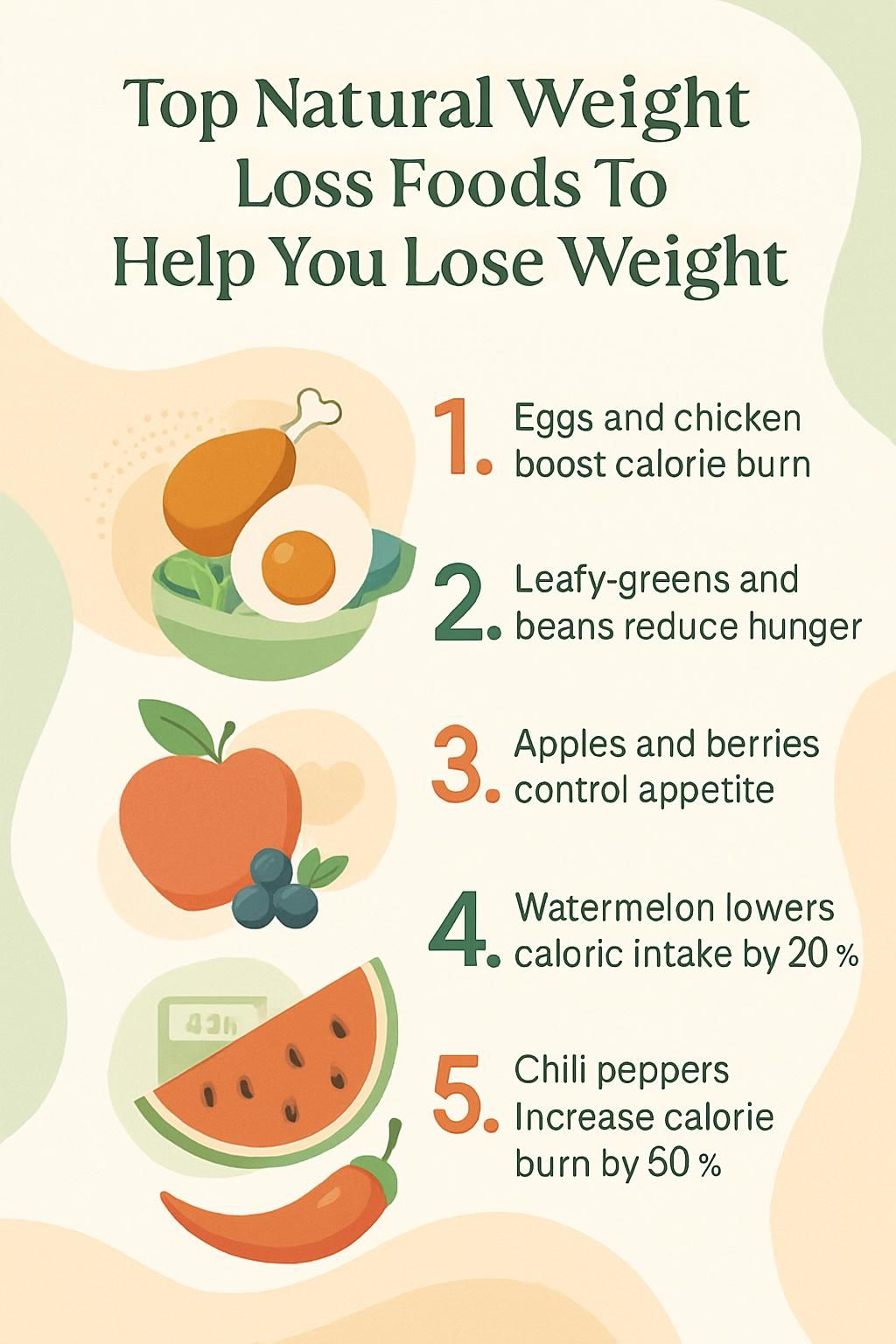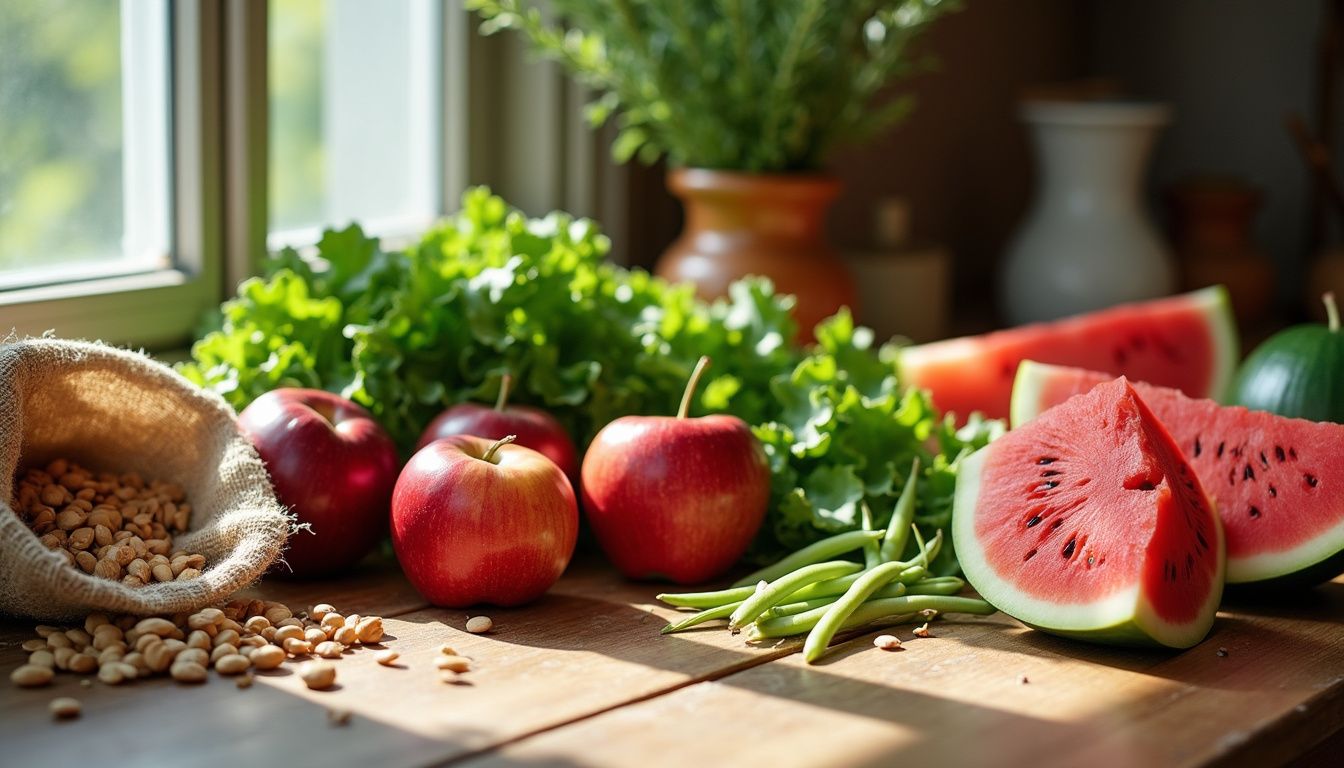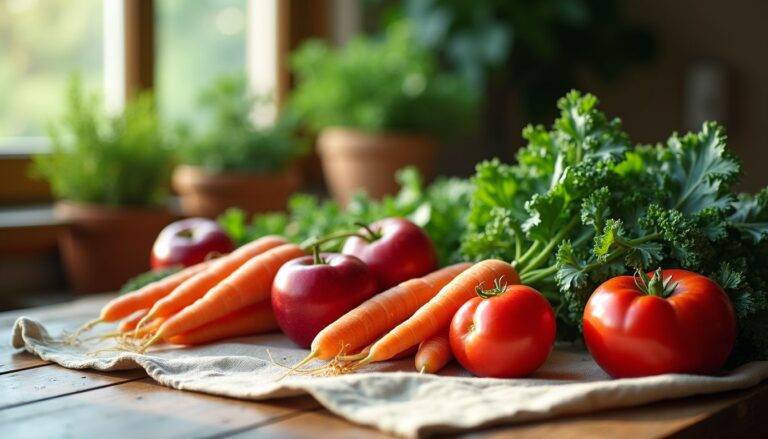Top Natural Weight Loss Foods To Help You Lose Weight
Our Nutrition Assistant AI Suite will transform your body. You will lose fat, get toned, and build muscle. Gain confidence and optimal health.
If you want to lose weight, choosing the right foods can feel confusing. Natural weight loss foods like fruits and vegetables help you feel full with fewer calories, which makes healthy eating easier.
This guide shows which fat-fighting foods work best, why they help, and simple ways to add them to daily meals. Learn how these nutritious choices support steady progress and better energy.
Key Takeaways
- High-protein foods like eggs, chicken breast, and Greek yogurt help you feel full longer and raise calorie burn during digestion, supporting weight loss (Obesity Reviews).
- Fiber-rich choices such as leafy greens, cruciferous vegetables, beans, and whole grains reduce hunger and lower body fat, according to a 2019 systematic review in Advances in Nutrition.
- Fruits including apples, berries at 84 calories per cup, grapefruit at 52 calories per half, and avocado with about 10 grams of fiber per fruit can improve fullness without excess calories.
- Foods high in water content, like watermelon at 92 percent water with 37 calories per wedge and cucumbers at 95 percent water with 16 calories each, plus low-calorie soups, can reduce meal intake by about 20 percent (Appetite, Rolls BJ et al., 2007).
- Metabolism helpers such as chili peppers with capsaicin may add about 50 calories to daily burn, and green tea can increase energy use by 3 to 4 percent per day.

Why Are Natural Weight Loss Foods Important?

Natural weight loss foods let you eat fewer calories while staying satisfied. They are low in calories and unhealthy fats, yet high in fiber, protein, vitamins, and minerals.
Research shows people who eat more fruits, vegetables, whole grain options, and high fiber foods tend to weigh less and have lower risk of obesity and type 2 diabetes. A review in Obesity Reviews reports that fiber from beans, legumes, and whole grains slows digestion and promotes fullness.
Most days, building meals around these foods improves weight management and overall health. I struggled with late-night snacking until I added Greek yogurt and apples, which kept me full and steady.
Water and fiber rich foods like leafy greens and melon add volume, so you feel full on fewer calories than your body burns.
“A healthy diet is built on a foundation of whole, nutrient-dense foods.”
High-Protein Foods for Weight Loss
Protein keeps you full, protects muscle while dieting, and slightly increases calorie burn through digestion. Add at least one lean protein to each meal.
What Are the Benefits of Eggs for Weight Loss?
Eggs provide high quality protein for very few calories. One large egg has about 70 calories and more than 6 grams of protein. Protein digests slowly, which helps control hunger and improves appetite control later in the day.
Studies show an egg-based breakfast can reduce total calories eaten over the next 24 hours. Eggs also supply vitamin D, vitamin B12, and selenium, and they do not spike blood sugar or insulin.
Scramble two eggs with spinach, or top whole grain toast with a poached egg. Simple cooking methods make eggs an easy, filling choice for a weight-loss plan.
How Does Chicken Breast and Lean Meats Help You Lose Weight?
Chicken breast and other lean meats are high in protein but lower in calories than fatty cuts. Your body uses more energy digesting protein than carbs or fat. For every 100 calories of protein consumed, about 20 to 30 calories are burned through digestion.
Choosing lean cuts supports fullness and daily calorie control. Grilled chicken breast at lunch often keeps my appetite in check until dinner.
High-protein foods like lean meat can help reduce appetite and calorie intake, says the American Heart Association.
Swap processed meats for grilled, baked, or broiled lean options. You also get iron and zinc, which support energy and immunity.
Why Include Fish and Shellfish in Your Weight Loss Diet?
Fish and shellfish offer lean protein plus omega-3 fatty acids, the healthy fats found in salmon, sardines, and mackerel. Omega-3s can reduce inflammation and may improve metabolism.
A 3 ounce serving of cooked salmon gives about 22 grams of protein with fewer calories than many fatty red meats. Reviews suggest higher fish intake may support weight loss compared to higher calorie patterns.
Try grilled shrimp on a salad or canned tuna on whole grain bread with light dressing. These simple meals are fast, satisfying, and calorie smart.
How Does Greek Yogurt Support Weight Loss?
Greek yogurt has more protein than regular yogurt, which helps you feel full longer. A single serving can provide up to 17 grams of protein for about 100 calories, depending on the brand.
As a dairy product rich in calcium, it may also support fat metabolism and preserve lean muscle during dieting. Choose plain varieties, then add berries, sliced apples, or seeds to increase fiber content and flavor without extra sugar.
Fiber-Rich Foods to Keep You Full
Dietary fiber is the part of plants your body cannot fully digest. It slows digestion, stabilizes blood sugar, and improves fullness between meals.
What Are the Weight Loss Benefits of Leafy Greens?
Leafy greens like spinach, kale, romaine, and Swiss chard are very low in calories yet rich in fiber. A big portion adds bulk to your plate without adding many calories.
One cup of raw spinach has about 7 calories and more than half a gram of fiber. Greens also provide vitamins A, C, and K plus minerals such as iron and potassium.
Use a large salad as your meal base, then add chicken breast, beans, or salmon for staying power. This approach makes hunger easier to manage between meals.
How Do Cruciferous Vegetables Help Control Hunger?
Cruciferous vegetables include broccoli, cauliflower, cabbage, and Brussels sprouts. They pack fiber and a bit of protein compared to many other vegetables.
One cup of cooked broccoli offers about 5 grams of fiber and nearly 4 grams of protein. This combination slows digestion and boosts satiety.
Roast a pan of broccoli or cauliflower for a crunchy side. I often add roasted broccoli to my lunch, which helps curb afternoon cravings.
Why Eat Beans and Legumes for Weight Loss?
Beans and legumes like lentils and chickpeas are rich in both fiber and protein. A half cup of cooked lentils provides about 8 grams of fiber and 9 grams of protein.
Higher intake is linked with lower body weight and better blood sugar control, which reduces spikes and cravings. Add black beans to grain bowls, toss chickpeas into salads, or simmer lentil soup for a warm, filling meal.
How Do Whole Grains Like Quinoa and Oats Aid Weight Loss?
Whole grains contain all parts of the grain, which means more fiber, vitamins, and minerals. One cup of cooked quinoa has around 8 grams of protein and 5 grams of fiber. A cooked cup of oatmeal gives roughly 4 grams of fiber.
This mix helps keep you full and supports steadier energy. Many whole grains also have a low glycemic index, meaning they cause smaller rises in blood sugar.
I like oatmeal with whole fruit in the morning or quinoa added to salads at lunch. Both keep me satisfied for hours.
Evidence supports these benefits. A 2019 systematic review found that higher whole grain intake is linked with lower body fat compared to lower intakes [1].
[1] “Whole grain intake and body weight: Results from observational studies.” Systematic Review, Advances in Nutrition, Sept 1, 2019
Fruits That Support Weight Loss
Raw fruits and vegetables add volume and fiber, which can help your body burn more fat over time. Here are standout picks to manage hunger with fewer calories.
How Do Apples Help You Lose Weight?
Apples are rich in water and fiber. One medium apple offers about 4 grams of fiber, which slows digestion and supports fullness.
Eating an apple before a meal may reduce total calories eaten. Chewing also takes time, which gives your brain a chance to register fullness.
Pair apple slices with a small handful of nuts or a spoon of peanut butter for a balanced, satisfying snack.
Why Are Berries Good for Weight Loss?
Berries like blueberries and raspberries provide plenty of fiber for very few calories. A cup of blueberries has about 84 calories and nearly 4 grams of fiber.
Their natural sweetness helps satisfy dessert cravings without added sugar. Stir berries into Greek yogurt or cottage cheese for a protein rich snack.
Adding blackberries to morning toast with a thin layer of nut butter keeps me satisfied until lunch. Antioxidants in berries support overall health while you lose weight.
Can Grapefruit Boost Weight Loss?
Grapefruit is a high water, low calorie fruit. Half a grapefruit has about 52 calories, and its volume helps you feel full.
In a 2006 study, participants who ate half a grapefruit before meals lost more weight over 12 weeks than those who did not. Grapefruit may also slightly lower insulin, which can encourage the body to use stored fat.
Enjoy fresh grapefruit with breakfast or add segments to a salad. Grapefruit can interact with some medicines such as statins, so speak with your healthcare provider if you take prescriptions.
How Does Avocado Support Weight Loss?
Avocado adds healthy fats and fiber to meals. One fruit provides roughly 10 grams of fiber, which helps control appetite for hours.
Most of its fat is monounsaturated, which supports heart health and steady energy. Swap mayonnaise or heavy dressings with mashed avocado on whole grain toast or in tuna salad.
Studies show people who include avocado at meals feel more satisfied, which can reduce snacking later.
Vegetables That Boost Metabolism
Some vegetables support a slightly higher calorie burn by adding fiber and key nutrients. Think of them as small sparks for your metabolism.
How Does Broccoli Increase Metabolism?
Broccoli supplies fiber, vitamin C, and calcium. Fiber requires more energy to digest, which raises calorie burn a bit. A cup of cooked broccoli has about 5 grams of fiber and only 55 calories.
It also contains glucosinolates, plant compounds that help activate detox enzymes. Add steamed broccoli to rice bowls or sauté it with garlic for a filling side.
I noticed that adding broccoli to lunch left me more energized through the afternoon.
What Are the Metabolism Benefits of Asparagus?
Asparagus is rich in fiber and B vitamins, which help your body turn food into energy. Fiber improves fullness and supports steady blood sugar.
It also provides potassium, which supports fluid balance and normal muscle contractions. Roast asparagus with olive oil, or pair it with eggs or chicken for a nutrient dense meal.
Can Carrots Help Speed Up Metabolism?
Carrots bring fiber and water with very few calories. One medium carrot has about 25 calories, yet it helps keep snacks light and satisfying.
They are rich in beta carotene and vitamins that support overall metabolism. Crunchy texture slows eating, which can reduce mindless snacking.
Sliced carrots with hummus add protein and make a steady, portable snack.
How Does Zucchini Support a Faster Metabolism?
Zucchini is low in calories and high in water, which boosts meal volume without adding many calories. Gentle fiber helps stabilize blood sugar and slow digestion.
It is also a source of potassium and vitamin C. Add zucchini to soups, stir-fries, or egg scrambles. A pinch of chili or black pepper provides heat and extra flavor.
Healthy Fats for Sustainable Weight Loss
Healthy fats help you stay satisfied, so you eat fewer calories overall. Choose sources rich in unsaturated fat more often than saturated fat.
Why Are Nuts and Seeds Good for Weight Loss?
Nuts and seeds combine protein, fiber, and healthy fats. These nutrients keep you full and can reduce cravings for sweets or chips.
Almonds or walnuts offer about 6 grams of protein per ounce. Chia seeds deliver around 10 grams of fiber per ounce and valuable minerals like magnesium and zinc.
People who include nuts regularly tend to maintain a healthier weight. A small handful of mixed nuts between meals often keeps my hunger steady.
How Does Olive Oil Promote Weight Loss?
Olive oil provides monounsaturated fats that support heart health and appetite control. Adding a small amount to meals can increase satisfaction and reduce the need for snacks.
Research links diets higher in monounsaturated fats with more consistent weight loss than strict low fat patterns. Drizzle extra virgin olive oil on steamed vegetables like broccoli or zucchini for flavor and satiety.
Using olive oil instead of butter can also help lower inflammation and support a healthier metabolism.
What Role Does Avocado Play in Healthy Fats?
Avocado delivers about 15 grams of monounsaturated fat per medium fruit. These fats can improve fullness after meals and support heart health.
It also provides potassium, vitamin E, and a small amount of protein. Add slices to salads, smoothies, or sandwiches for a creamy texture without heavy dressings.
This swap reduces saturated fat and supports long-term wellness.
Foods with High Water Content to Promote Satiety
High water foods fill your stomach with few calories. They help control hunger and make portion control easier.
How Does Watermelon Help You Feel Full?
Watermelon is about 92 percent water, so it hydrates and satisfies. One large wedge has roughly 37 calories, yet the volume feels generous.
Cold watermelon works as a sweet, low calorie snack on hot days. I often choose it instead of chips, which helps curb cravings in the afternoon.
Combine watermelon with other hydrating foods, such as cucumbers, for even more fullness.
Why Are Cucumbers Effective for Satiety?
Cucumbers are 95 percent water and very low in calories. A medium cucumber has about 16 calories, which makes it a smart snack or side.
Add slices to salads, wraps, or grain bowls. Sprinkle with a little salt and serve with Greek yogurt for extra protein.
This simple combo keeps me satisfied longer than crackers or chips.
Can Soups Help Control Hunger?
Soup adds water and vegetables to your meal, which lowers calorie density. Having a bowl of vegetable soup before lunch can reduce the calories you eat later.
In one 2007 study, people who ate low calorie soup before lunch consumed about 20 percent fewer calories during the main course. Warm soup also slows your eating pace, which helps your body register fullness.
On busy days, I rely on homemade chicken and vegetable soup with jalapeño for flavor. Beans, sweet potato, or barley increase fiber and make soup more filling.
1: Rolls BJ et al., Appetite (2007)
Metabolism-Boosting Foods
Certain foods can nudge your metabolism higher for a short time. Use them as small helpers alongside a balanced plan.
How Do Chili Peppers Speed Up Metabolism?
Chili peppers contain capsaicin, a compound that increases heat production in your body for a short period. This effect is called diet induced thermogenesis.
Research suggests capsaicin can raise daily energy burn by about 50 calories in adults. It may also reduce appetite slightly.
Add chopped chili to eggs, stir-fries, or roasted vegetables. I use a little at dinner, which makes meals more flavorful and satisfying.
What Are the Weight Loss Benefits of Green Tea?
Green tea contains catechins, antioxidants that can support fat burning and improve metabolism. Studies show daily calorie burn can rise by 3 to 4 percent.
Caffeine in green tea can boost alertness, which may help you move more. Replace sugar sweetened drinks with unsweetened green tea to lower calories and improve hydration.
Can Cinnamon Help Boost Metabolism?
Cinnamon may improve how your body handles sugar. Some studies indicate it can enhance insulin sensitivity and help stabilize blood sugar.
The compound cinnamaldehyde in cinnamon appears to activate energy use in fat cells. Sprinkle cinnamon on oatmeal, yogurt, or sliced apples. While the effect is modest, it can support a healthier pattern when paired with smart meals and regular exercise.
Probiotic Foods for a Healthy Gut
Your gut hosts trillions of bacteria, called the microbiome. A balanced microbiome supports digestion, immune health, and weight management.
How Does Low-Fat Milk Support Gut Health?
Low fat milk provides calcium and vitamin D for bones and muscles. The natural milk sugar, lactose, can feed helpful bacteria in your gut.
Some low fat dairy products also include added probiotics. A serving with breakfast, such as milk over whole grain cereal or with oatmeal and orange slices, adds protein and steady energy without excess fat.
Why Include Cottage Cheese for Gut Health?
Cottage cheese can contain live cultures if labeled cultured or containing live and active cultures. These probiotics help maintain a healthy balance of gut bacteria.
One cup delivers about 28 grams of protein, which supports fullness and muscle maintenance. I often pair cottage cheese with fresh fruit or berries for extra fiber and flavor.
What Are the Benefits of Fermented Foods Like Yogurt and Kimchi?
Fermented foods such as yogurt and kimchi provide probiotics that support digestion and may reduce inflammation. Better digestion can help your body absorb nutrients more efficiently.
Plain Greek yogurt offers both probiotics and high protein to improve satiety. Kimchi supplies fiber, vitamins, and bright flavor that pairs well with rice or eggs.
A small serving of Greek yogurt each morning helped me avoid midmorning hunger and kept my stomach calm.
Tips for Incorporating Weight Loss Foods into Your Diet
Small, consistent changes build strong habits. Use these strategies to make your eating plan easier to follow.
How Can Combining Protein, Fiber, and Healthy Fats Aid Weight Loss?
Meals that mix protein, fiber, and healthy fats control hunger better than low fat meals alone. Protein protects muscle and slightly raises calorie burn during digestion.
Fiber slows the rise in blood sugar and extends fullness. Healthy fats from avocado, nuts, seeds, and olive oil further improve satisfaction.
Example plate: spinach salad with grilled chicken breast, quinoa, olive oil, and pumpkin seeds. Studies in the Journal of Nutrition link this balanced approach with stronger weight loss results.
Why Should You Avoid Sugary and Processed Foods?
Sugary and ultra processed foods are high in added sugars and unhealthy fats. They can cause blood sugar spikes, followed by hunger and overeating.
Diets high in added sugar raise the risk of weight gain, type 2 diabetes, and heart disease. One JAMA analysis found people getting more than 25 percent of calories from sugar were twice as likely to die from heart disease compared with lower sugar intake.
Focusing on natural weight loss foods helps you stay full and energized. Swapping processed snacks for fruit and nuts made my cravings easier to manage.
How Does Consistent Portion Control Help You Lose Weight?
Portion control means eating the right amount for your goals. Measuring servings with cups or a food scale gives a clearer picture of calorie intake.
Research shows that smaller plates and measured portions can reduce daily calories. Many people cut intake by around 22 percent with smaller plates.
Keep portions steady instead of banning favorite foods. This strategy supports long term adherence and less stress around eating.
Conclusion
Natural weight loss foods make it easier to eat fewer calories and still feel satisfied. High protein choices support muscle and fullness. Fiber rich vegetables and fruits tame hunger and provide steady energy.
Healthy fats from nuts, seeds, olive oil, and avocado improve satisfaction and heart health. High water foods like melon, cucumber, and soup add volume for very few calories. Probiotic foods support a healthy gut, which may help with weight management.
Use these foods daily to build a sustainable weight loss plan. This article is for education and is not medical advice. If you have a health condition or take medication, consult a qualified healthcare professional first.
FAQs
1. What are the best natural foods for weight loss?
Whole grains, leafy greens, legumes, berries, and lean poultry support weight loss. These foods are low in calories and high in fiber, which helps you feel full longer. Research from the Harvard School of Public Health shows that people who eat more fiber-rich foods tend to lose more weight over time.
2. How do natural foods help with weight loss?
Natural foods like vegetables, fruits, and beans contain fewer calories and more nutrients than processed foods. They also have more water and fiber, which can reduce hunger. Studies published in the American Journal of Clinical Nutrition confirm that high-fiber diets are linked to lower body weight.
3. Can eating more protein-rich foods help me lose weight?
Yes, protein-rich foods such as eggs, fish, and beans can help with weight loss. Protein increases feelings of fullness and may boost metabolism. A study in the journal Obesity found that people who increased their protein intake lost more weight than those who did not.
4. What is a simple way to add natural weight loss foods to my meals?
Start by replacing refined grains with whole grains and add more vegetables to each meal. For example, I began eating oatmeal for breakfast instead of sugary cereal. This change helped me feel full until lunch and made it easier to avoid snacks.
Summary: Choosing whole grains, vegetables, fruits, beans, and lean poultry can help with weight loss. These foods are high in fiber or protein and low in calories. Research supports their benefits for reducing hunger and supporting healthy weight loss. Simple changes like swapping refined grains for whole ones make a difference over time.







